As its name says, salmon is the rule at this chic, bar-style eatery near Sun Yat-sen Memorial Hall.
Opened by Marine Harvest, a Norwegian seafood company, Supreme Salmon serves up generous portions of the fish in an array of dishes using recipes from around the world. Think Thai curry salmon (NT$320), salmon sashimi (NT$280), salmon pasta with pesto sauce (NT$280), locally-flavored three-cup salmon (NT$290) … and the list goes on. Diners can choose between two set meals for an additional NT$49 and NT$79.
The restaurant is part of Marine Harvest’s NT$100 million venture in Taiwan, which includes a fish processing plant in Jhongli (中壢) and so far two restaurants and one culinary classroom in Taipei.
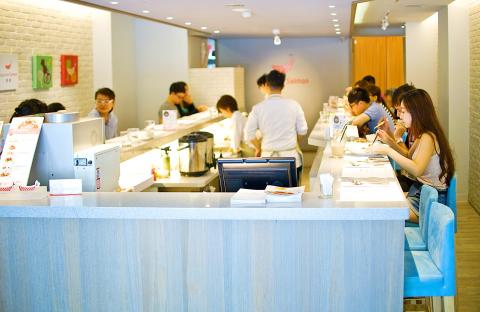
Photo: Han Cheung, Taipei Times
It’s easy to walk past Supreme Salmon, which is a hole in the wall on the ground floor of a massive office building. The decor is Scandinavian — brick walls painted white accentuated with square, bright-colored paintings. There’s no regular seating — diners sit around a tall, three-sided bar with staff taking orders and serving food from inside, reminiscent of a Japanese teppanyaki or sushi joint.
The minimalist environment calls for quiet eating, and the atmosphere is pleasant with faint jazz playing in the background.
With four in our party, we sampled dishes from different parts of the world.
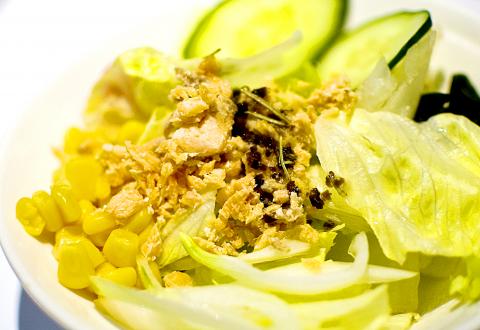
Photo: Han Cheung, Taipei Times
The set menu comes with a choice of salad, miso or minestrone soup. We all ordered the salad, which is topped with crumbled salmon. The light, sweet vinaigrette is refreshing, and it is balanced by the savory fish. It is all brought together by the kick of raw onion slices and the subtle flavors of rosemary.
First up was the grilled salmon with Japanese curry rice (NT$250). The salmon is perfectly crispy on the outside, while the meat is tender and juicy. It’s also a pretty generous portion for the price. While the use of apples gives a tang to the curry, the sauce as a whole doesn’t really stand out.
The salmon omelet (NT$250) isn’t really an omelet — the rice dish is topped with a thin sheet of half-cooked scrambled egg. Still, it was probably my favorite dish. The salmon is less noticeable in this dish since it’s broken up and mixed with the rice — which is a bit disappointing at first, but once you start eating it, all the flavors and textures of the runny egg, salmon chunks, slightly-sweet sauce and chewy rice come together in a delicious symphony.
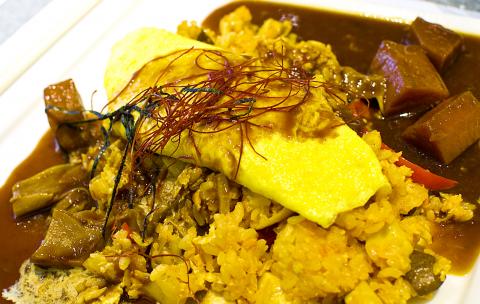
Photo: Han Cheung, Taipei Times
The Thai yellow curry with salmon and spring bamboo (NT$320) is on the spring and summer special set menu. The curry, with hints of coconut and lemongrass, is excellent, but I felt like the restaurant tried to do too much by adding raw egg white to the finished product, making it a bit too slithery. The salmon is sliced into chunks and served in the curry sauce, which I feel causes it to become soft and lose the grilled crispness on the outside, which, when coupled with the egg white, does not make for the best texture.
The final dish was the truffle risotto with salmon and mushroom (NT$340). Speaking of textures, this dish is as versatile as can be — stringy cheese, chewy rice, grilled-to-perfection salmon and various types of mushrooms in a cream-based sauce. Again, everything works together here, and something different can be explored with each bite. The sauce is rich but not overpowering, allowing the aroma of the fish to shine. The punchier flavors of garlic and truffles definitely add to this multi-layered concoction.
It was a great meal overall. Service was quick and the ingredients fresh. If you have ideas of your own, the store also sells packaged salmon so you can try your own Supreme Salmon recipes.
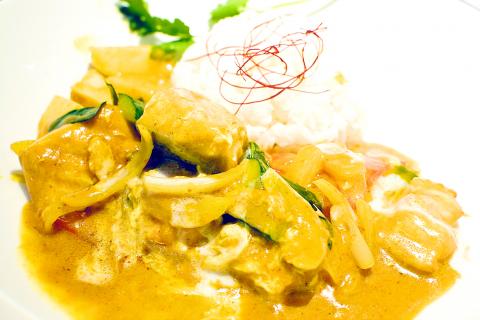
Photo: Han Cheung, Taipei Times
Supreme Salmon has another location in the food court of Eslite Xinyi bookstore (誠品信義店), B2, 11, Songgao Rd, Taipei City (台北市松高路11號B2), tel: (02) 2720-0177.
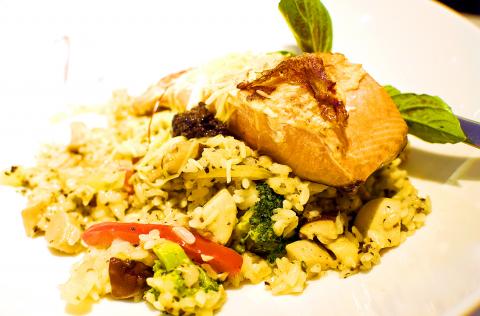
Photo: Han Cheung, Taipei Times

In the March 9 edition of the Taipei Times a piece by Ninon Godefroy ran with the headine “The quiet, gentle rhythm of Taiwan.” It started with the line “Taiwan is a small, humble place. There is no Eiffel Tower, no pyramids — no singular attraction that draws the world’s attention.” I laughed out loud at that. This was out of no disrespect for the author or the piece, which made some interesting analogies and good points about how both Din Tai Fung’s and Taiwan Semiconductor Manufacturing Co’s (TSMC, 台積電) meticulous attention to detail and quality are not quite up to

April 21 to April 27 Hsieh Er’s (謝娥) political fortunes were rising fast after she got out of jail and joined the Chinese Nationalist Party (KMT) in December 1945. Not only did she hold key positions in various committees, she was elected the only woman on the Taipei City Council and headed to Nanjing in 1946 as the sole Taiwanese female representative to the National Constituent Assembly. With the support of first lady Soong May-ling (宋美齡), she started the Taipei Women’s Association and Taiwan Provincial Women’s Association, where she

Chinese Nationalist Party (KMT) Chairman Eric Chu (朱立倫) hatched a bold plan to charge forward and seize the initiative when he held a protest in front of the Taipei City Prosecutors’ Office. Though risky, because illegal, its success would help tackle at least six problems facing both himself and the KMT. What he did not see coming was Taipei Mayor Chiang Wan-an (將萬安) tripping him up out of the gate. In spite of Chu being the most consequential and successful KMT chairman since the early 2010s — arguably saving the party from financial ruin and restoring its electoral viability —

It is one of the more remarkable facts of Taiwan history that it was never occupied or claimed by any of the numerous kingdoms of southern China — Han or otherwise — that lay just across the water from it. None of their brilliant ministers ever discovered that Taiwan was a “core interest” of the state whose annexation was “inevitable.” As Paul Kua notes in an excellent monograph laying out how the Portuguese gave Taiwan the name “Formosa,” the first Europeans to express an interest in occupying Taiwan were the Spanish. Tonio Andrade in his seminal work, How Taiwan Became Chinese,